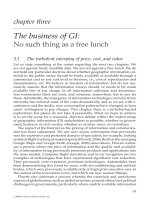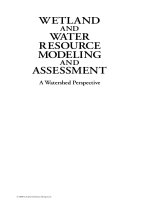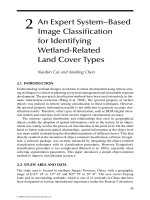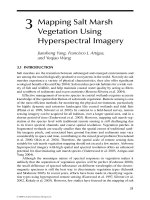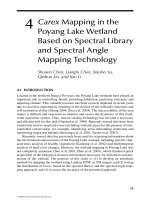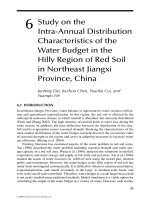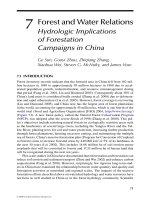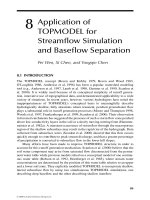WETLAND AND WATER RESOURCE MODELING AND ASSESSMENT: A Watershed Perspective - Chapter 3 doc
Bạn đang xem bản rút gọn của tài liệu. Xem và tải ngay bản đầy đủ của tài liệu tại đây (499.61 KB, 8 trang )
21
3
MappingSaltMarsh
Vegetation Using
Hyperspectral Imagery
Jiansheng Yang, Francisco J. Artigas,
and Yeqiao Wang
3.1 INTRODUCTION
Salt marshes are the transition between submerged and emerged environments and
are among the most biologically productive ecosystems in the world. Not only do salt
marshes experience a variety of physical characteristics, they also offer signicant
ecological benets (Ko and Day 2004). Salt marshes provide habitats for a wide vari-
ety of sh and wildlife, and help maintain coastal water quality by acting as lters
and scrubbers of sediments and excess nutrients (Herrera-Silveira et al. 2004).
Effective management of invasive species in coastal wetlands requires accurate
knowledge of the spatial distribution of salt marsh vegetation. Remote sensing is one
of the most efcient methods for monitoring the physical environment, particularly
for highly dynamic and extensive landscapes like coastal wetlands and tidal ats
(Phinn et al. 1999, Silvestri et al. 2003). In contrast to a eld-based survey, remote
sensing imagery can be acquired for all habitats, over a larger spatial area, and in a
shorter period of time (Underwood et al. 2003). However, mapping salt marsh veg-
etation at the species level with traditional remote sensing is still challenging due
to its fewer spectral channels and coarse spatial resolution. Vegetation patches in
fragmented wetlands are usually smaller than the spatial extent of traditional satel-
lite imagery pixels, and associated bare ground fractions and sediments may vary
considerably in space and time, contributing to the mixed pixel problem (Townshend
et al. 2000, Okin et al. 2001). Therefore, the spatial scale of remote sensing data
suitable for salt marsh vegetation mapping should not exceed a few meters. Airborne
hyperspectral imagery with high spatial and spectral resolution offers an enhanced
potential for discriminating salt marsh species (Underwood et al. 2003, Aritgas and
Yang 2004).
Although the nonunique nature of spectral responses in vegetation makes it
unlikely that the separation of vegetation species will be perfect (Cochrane 2000),
the small difference of spectral reectance on different wavelengths of the electro-
magnetic spectrum is still the best way to discriminate vegetation types (Schmidt
and Skidmore 2003). In recent years, efforts have been made in classifying vegeta-
tion types using hyperspectral remote sensing (Eastwood et al. 1997, Silvestri et al.
2002, Kokaly et al. 2003). However, few studies have focused on the mapping of salt
© 2008 by Taylor & Francis Group, LLC
22 Wetland and Water Resource Modeling and Assessment
marsh vegetation and invasive species in fragmented coastal wetlands. Schmidt and
Skidmore (2003), for example, examined and tested the differences of reectance
spectra of 27 vegetation types in the Dutch Waddenzee ecosystem and concluded
that salt marsh vegetation types may be identied from well-calibrated hyperspectral
imagery using a spectral library measured in the eld. In another study, Silvestri
et al. (2003) used a linear unmixing technique to separate salt marsh vegetation
communities in a Venice lagoon in northeastern Italy. Authors also tested spectral
discrimination of salt marsh species in the Meadowlands in northern New Jersey in
a previous study of mapping vigor gradients of salt marsh vegetation (Artigas and
Yang 2005). The objectives of this study were (1) to investigate the use of hyperspec-
tral imagery in mapping salt marsh vegetation in a coastal wetland, and (2) to evalu-
ate the methods of endmembers selection in hyperspectral image classication.
3.2 STUDY AREA AND DATA
The New Jersey Meadowlands is located in northeastern New Jersey, approximately
three miles west of New York City. It is a mixture of highly developed residential
and industrial land uses interspersed among expanses of landlls, marsh grass elds,
tidal wetlands creeks, mudats, and rivers (Figure 3.1). There are approximately
Band 32
Band 17
Band 2
N
EW
S
0 2 4 8 12 16
Kilometers
FIGURE 3.1 False color composite (RGB = 32:17:2) of AISA hyperspectral imagery of the
New Jersey Meadowlands. (See color insert after p. 162.)
© 2008 by Taylor & Francis Group, LLC
Mapping Salt Marsh Vegetation Using Hyperspectral Imagery 23
34 km
2
of wetlands and open water within the Meadowlands, and 12 km
2
of salt
marsh vegetation including high marsh species Patens (Spartina patens) and Dis-
tichlis (Distichlis spicata), and low marsh species Spartina (Spartina alterniora).
The invasive species, Phragmites, outcompetes the native species and results in thick
stands of up to 4 ~ 5 meters high on tide-restricted areas, higher elevation dredge
spoil islands, and tidal creek banks and levees.
Hyperspectral imagery of the New Jersey Meadowlands was acquired on 11
October 2000 using Airborne Imaging Spectroradiometer for Applications (AISA).
AISA is a solid-state, push-broom instrument capable of collecting data within a
spectral range of 430 to 900 nm in up to 286 spectral channels. The sensor was
congured for 34 spectral bands from 452 to 886 nm and 20 degrees of eld of view
(FOV) at 2,500 m altitude, corresponding to a swath width of 881.6 m and pixel size
of 2.5 × 2.5 m. Atmospheric conditions on the day of image acquisition were clear
sky with 660 Watts/m
2
of solar irradiation at ground level, 55% of relative humidity,
and 18°C of surface temperature.
In situ reectance spectra of dominant salt marsh vegetation were collected from
relatively homogeneous 10 × 10 m plots at six different locations using a FieldSpec®
Pro Full Range Spectroradiometer from Analytical Spectral Devices (ASD 1997).
The spectroradiometer was congured to an eight degree of FOV at a height of 1.5
m, which gives a 0.26-m diameter ground extent. Field spectra measurements were
collected under clear skies within 1.5 hours of high sun and referenced to a Spec-
tralon® white reference panel before and after each sampling period. All prole
measurements were calculated by averaging 25 samples to reduce the noise.
3.3 METHODS
Both geometric and brightness corrections were conducted on the AISA image.
More than 200 ground control points (GCPs) were selected on both AISA imagery
and reference orthophoto for geometric correction. Each strip was warped to New
Jersey State Plane map projection (NAD83) using a nearest-neighbor resampling
algorithm with an average root-mean-square error (RMSE) of ±0.88 pixel (or ±2.2
m). Cross-Track Illumination Correction Function was used to eliminate brightness
distortion between strips (Research Systems, Inc. [RSI] 2003). After corrections,
22 AISA strips were mosaicked into a single seamless image and then subset to the
Meadowlands district (Figure 3.1). Considering that not all 34 spectral bands con-
tributed useful information, a minimum noise fraction (MNF) rotation was applied
to reduce the computation (Underwood et al. 2003). Based on the MNF output graph
of eigenvectors, the rst 15 MNF bands were chosen for further analysis and vegeta-
tion mapping.
Normalized difference vegetation index (NDVI) is a measure of density and
vigor of green vegetation growth using the spectral reectivity of solar radiation and
is usually derived from the following equation (Carlson and Ripley 1997):
© 2008 by Taylor & Francis Group, LLC
NDVI
nir red
nir red
=
−
( )
+
( )
α α
α α
(3.1)
24 Wetland and Water Resource Modeling and Assessment
where F
red
and F
nir
represent surface reectance averaged over ranges of wavelengths
in the red (500 to 700 nm) and near infrared (700 to 900 nm) regions of the electro-
magnetic spectrum, respectively.
Band 12 around 600 nm and band 28 near 800 nm of the AISA image were selected
to calculate the NDVI image in this study. Pixels with NDVI values less than 0.3
were selected as a mask to remove nonvegetated pixels such as impervious surfaces,
open water, and mud from the image so that the retained image contains only veg-
etated pixels. Other vegetated pixels, such as those of upland forest stands, were then
removed using a second mask generated from a land use map.
Two methods were used to select endmembers spectra in this study. One was to
select endmembers from a spectral library, which consists of 17 spectra of salt marsh
surfaces collected in the eld. The reectance spectra of ve selected endmembers
from the spectral library are shown in Figure 3.2a. The other method was to select end-
members from the AISA image by locating pure pixels areas with monospecic veg-
etation through direct eld inspection (Kokaly et al. 2003). Six endmembers selected
in this way include high marsh, Spartina pure, Spartina mixture, Spartina/Phragmites
stunted, Phragmites big ower, and Phragmites small ower (Figure 3.2b).
After endmembers selection, a supervised classier, the spectral angle map-
per (SAM), was used to perform image classication on 15 MNF bands. The SAM
algorithm determines the similarity of two spectra by calculating the spectral angle
between each spectrum in the image and the endmembers in n dimensions, treating
them as vectors in a space with dimensionality equal to the number of bands (Kruse
et al. 1993). The maximum angles between 0.05 and 0.2 were used in the SAM clas-
sication, and the angle that resulted in the highest map accuracy was chosen for
nal vegetation mapping.
3.4 RESULTS AND DISCUSSION
Figure 3.2a shows typical reectance spectra of salt marsh vegetation species mea-
sured in the eld. The two high marsh species, Distichlis and Patens, are difcult
to separate in the visible region, but they are separable spectrally in the near-infra-
red region. In addition, native vegetation species can be easily separated from the
invasive Phragmites, while the separation between the two native species Patens
and Spartina is not easy. Figure 3.2b shows the typical reectance spectra of salt
marsh vegetation derived from the AISA image by eld inspection. Distichlis and
Patens were combined into one category as high marsh, and low marsh was divided
into Spartina pure, Spartina mixture, and Spartina stunted. Marsh reed was also
grouped into two categories: Phragmites big ower (higher than or equal to six feet)
and small ower (lower than six feet).
Some differences exist between eld-measured and image-derived endmem-
bers spectra. First, except for stunted species, reectance spectra of all other species
derived from the image are lower than those measured in the eld. Second, the reec-
tance of eld-measured endmembers increased in the order of Distichlis, Spartina,
and Phragmites in the near-infrared region, while the reectance of image-derived
endmembers increased in the order of Spartina, Phragmites, and Distichlis in the
© 2008 by Taylor & Francis Group, LLC
Mapping Salt Marsh Vegetation Using Hyperspectral Imagery 25
Endmembers from Field Measurements
0
0.1
0.2
0.3
0.4
0.5
455 526 560 619 671 713 767 813 861
Wavelength (nm)
(a)
Reflectance
Phragmites
Spartina
Patens
Distichlis
Spartina stunted
455 526 560 619 671 713 767 813 861
Endmembers from AISA Image
0
0.1
0.2
0.3
0.4
Wavelength (nm)
(b)
Reflectance
High marsh
Phragmites big flower
Phragmites small flower
Spartina mixture
Spartina pure
Spartina stunted
FIGURE 3.2 Endmembers spectra derived from (a) eld measurements with spectro-
radiometer, and (b) the area of pixels with monospecic vegetation in AISA imagery through
eld inspection.
© 2008 by Taylor & Francis Group, LLC
26 Wetland and Water Resource Modeling and Assessment
same region. This is most likely because the locations of training sites selected from
the image are different from those measured in the eld. Another possible reason
is due to the atmosphere that was not completely accounted for through the atmo-
spheric correction. Further atmospheric correction is needed to remove the water
vapor absorption effects, which exist in 760 nm and 830 nm in Figure 3.2b.
The spatial distribution of salt marsh vegetation in the Meadowlands is presented
in Figure 3.3. Phragmites occupies approximately 80% of the entire salt marsh veg-
etation in the Meadowlands, Spartina and its mixture 10%, high marsh only 1%,
and the remaining 10% are stunted Spartina/Phragmites. The accuracy assessment
was conducted rst on three main salt marsh surfaces: high marsh (Distichlis and
Patens), low marsh (Spartina and its mixtures), and marsh reed (Phragmites big and
small ower) using 38 ground truth points in the southern Meadowlands. The results
showed that the method using image-derived endmembers performed better, 85%
overall accuracy (kappa = 0.76) compared to 75% (kappa = 0.53) for the method
using eld-collected endmembers. In accuracy assessment conducted for ve veg-
etation species, image-derived endmembers also resulted in higher accuracy than
eld-collected endmembers. The method using image-derived endmembers resulted
in 63.2% overall accuracy (kappa = 0.53) for mapping ve species of salt marsh veg-
etation and 71.4% producer’s accuracy for mapping invasive Phragmites (Table 3.1).
Close examination of the salt marsh vegetation map revealed some possible
errors in salt marsh vegetation mapping. We found that many places are a mix-
ture of Phragmites and native species, which make the spectral discrimination dif-
cult. Phragmites-stunted and Spartina-stunted surrounding mud are also difcult
to distinguish due to the high moisture content. Ground truth points collected in the
southern portion of the Meadowlands may also generate bias for the accuracy in the
northern part of the Meadowlands. More ground truth points are needed to perform
a more reliable assessment for the entire Meadowlands.
Spartina/Phragmite stunted
Phragmite small flower
Phragmite big flower
Spartina mixture
Spartina pure
High marsh
0 2 4 8 12 16
W
N
S
E
Kilometers
FIGURE 3.3 Map of salt marsh vegetation in the New Jersey Meadowlands with the insert
of the Bend, which shows the detailed distribution of salt marsh species in six categories. (See
color insert after p. 162.)
© 2008 by Taylor & Francis Group, LLC
Mapping Salt Marsh Vegetation Using Hyperspectral Imagery 27
3.5 CONCLUSION
This study describes a method for mapping salt marsh vegetation and invasive spe-
cies using hyperspectral AISA imagery. Generally, the method using image-derived
endmembers resulted in higher mapping accuracy than the method using eld-col-
lected endmembers. More attention needs to be given to the atmospheric effects,
which make the spectra derived from the AISA image different from those mea-
sured in the eld. The results show that by carefully collecting endmembers from the
image through eld inspection, the SAM method is able to classify the hyperspec-
tral imagery with respect to salt marsh vegetation mapping at the species level with
acceptable accuracy. This study will contribute to the knowledge base of land man-
agers by providing improved information concerning spatial distribution and density
of salt marsh vegetation in coastal wetlands, which will lead to better understanding
and management of invasive species and its native biodiversity.
REFERENCES
Artigas, F. J., and J. Yang. 2004. Hyperspectral remote sensing of habitat heterogeneity
between tide-restricted and tide-open areas in New Jersey Meadowlands. Urban Habi-
tat 2(1):1–18.
Artigas, F. J., and J. Yang. 2005. Hyperspectral remote sensing of marsh species and plant
vigor gradient in the New Jersey Meadowland. International Journal of Remote Sens-
ing 26:5209–5220.
TABLE 3.1
Error matrix of the classified vegetation map derived from the AISA image
using image-derived endmembers in the New Jersey Meadowlands.
Reference Data
Classification
HM
marsh
SP
pure
SM
mixture
BF
Phragmites
SF
Phragmites
Row
Total
High marsh 11 0 0 0 0 11
Spartina pure 01 0 0 0 1
Spartina mix 21 2 2 1 8
Big ower Phragmites 30 1 5 110
Small ower Phragmites 00 0 0 5 5
Column total 16 5 3 7 7 38
Overall accuracy = 63.16 % Kappa coefcient = 0.5309
Producer’s Accuracy (%) User’s Accuracy (%)
High marsh (HM) 68.8 High marsh (HM) 100
Spartina pure (SP) 20.0 Spartina pure (SP) 100
Spartina mix (SM) 66.7 Spartina mix (SM)25
Big ower (BF) 71.4 Big ower (BF) 50
Small ower (SF) 71.4 Small ower (SF) 100
© 2008 by Taylor & Francis Group, LLC
28 Wetland and Water Resource Modeling and Assessment
ASD (Analytical Spectral Devices). 1997. Technical Guide. Boulder, CO: ASD.
Carlson, T. N., and D. N. Ripley. 1997. On the relation between NDVI, fractional vegetation
cover, and leaf area index. Remote Sensing of Environment 62:241–252.
Cochrane, M. A. 2000. Using vegetation reectance variability for species level classication
of hyperspectral data. International Journal of Remote Sensing 21(8):2075–2087.
Eastwood, J. A., M. G. Yates, A. G. Thomson, and R. M. Fuller. 1997. The reliability of
vegetation indices for monitoring salt marsh vegetation cover. International Journal of
Remote Sensing 18(18):3901–3907.
Herrera-Silveira, J. A., F. A. Comin, N. Aranda-Cirero, L. Troccoli, and L. Capurro. 2004.
Coastal water quality assessment in the Yucatan Peninsula: Management implications.
Ocean & Coastal Management 47(11–12):625–639.
Ko, J. Y., and J. D. Day. 2004. A review of ecological impacts of oil and gas development
on coastal ecosystems in the Mississippi Delta. Ocean & Coastal Management
47(11–12):597–623.
Kokaly, R. F., D. G. Despain, R. N. Clark, and K. E. Livo. 2003. Mapping vegetation in Yel-
lowstone National Park using spectral feature analysis of AVIRIS data. Remote Sensing
of Environment 84:437–456.
Kruse, F. A., A. B. Lefkoff, and J. B. Dietz. 1993. Expert system–based mineral mapping in
northern Death Valley, California/Nevada using the Airborne Visible/Infrared Imag-
ing Spectrometer (AVIRIS). Special issue on AVIRIS, Remote Sensing of Environment
44:309–336.
Okin, G. S., D. A. Roberts, B. Murray, and W. J. Okin. 2001. Practical limits on hyperspec-
tral vegetation discrimination in arid and semiarid environments. Remote Sensing of
Environment 77:212 –225.
Phinn, S. R., D. A. Stow, and D. Van Mouwerik. 1999. Remotely sensed estimates of vegeta-
tion structural characteristics in restored wetlands, Southern California. Photogramm.
Eng. Remote Sensing 65(4):485–493.
RSI (Research Systems, Inc.). 2003. ENVI 4.0 Users Guide.
Schmidt, K. S., and A. K. Skidmore. 2003. Spectral discrimination of vegetation types in a
coastal wetland. Remote Sensing of Environment 85:92–108.
Silvestri, S., M. Marani, and A. Marani. 2003. Hyperspectral remote sensing of salt marsh
vegetation, morphology and soil topography. Physics and Chemistry of the Earth 28:
15–25.
Silvestri, S., M. Marani, J. Settle, F. Benvenuto, and A. Marani. 2002. Salt marsh vegetation
radiometry: Data analysis and scaling. Remote Sensing of Environment 2:473–482.
Townshend, J. R. G., C. Huang, S. N. V. Kalluri, R. S. Defries, S. Liang, and K. Yang. 2000.
Beware of per-pixel characterization of land cover. International Journal of Remote
Sensing 21(4):839–843.
Underwood, E., S. Ustin, and D. DiPietro. 2003. Mapping nonnative plants using hyperspec-
tral imagery. Remote Sensing of Environment 86:150–161.
© 2008 by Taylor & Francis Group, LLC

